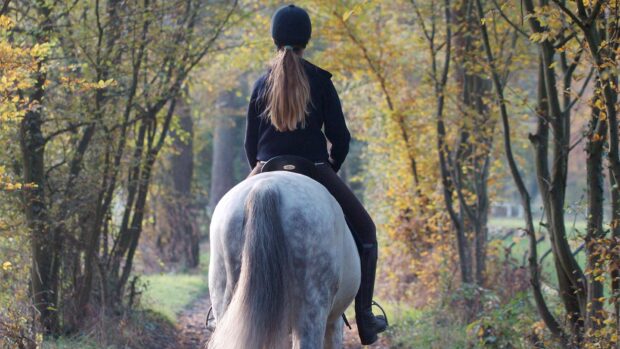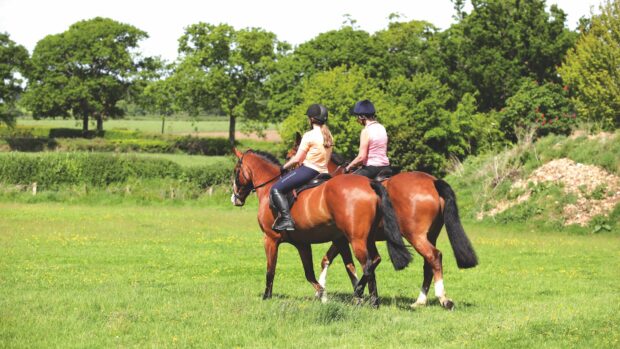Riding horses through cows might be commonplace on the plains of Montana, but in the UK on most hacking routes riders will not encounter livestock. Being confronted by a field full of cattle while out on a ride may cause alarm, but the majority of the time, livestock – whether sheep, cattle or other horses – on a public right of way present no issues to horses and riders. Pigs are anecdotally known to spook to many horses, but they are unlikely to cause an upset on purpose. Occasionally cattle may behave in a dangerous manner, leaving both you and your horse fearful or under threat. It is possible to appeal to a highway authority to have threatening animals removed, but you need evidence of their dangerous behaviour – rather than your horse simply being scared of a herd of ruminants.
In fact, in most parts of the world, equines co-exist quite happily with other livestock. For example, in Africa, where antelopes, zebras, elephants, giraffes, rhinos and others all graze in the same area. Before the Ice Age in Britain, wild horses grazed with bison, deer, woolly rhinos and wild cattle. However, our modern horses may not be used to the sight of flocks and herds of other species, so this needs addressing before heading through a field with livestock.
Preparing your horse to ride among livestock
The first step is to make sure your horse is well prepared. Your Horsemanship trainer Jason Webb grew up farming sheep and cattle off horseback in Australia, and advocates starting slowly with “what I term reasonable exposure”.
“Turn your horse out in a field where they can see livestock,” he suggests. “Or, if you know you are going to meet them on a hacking route, have a quiet, experienced horse between them and the cows or sheep, or start by leading them from the ground – as long as your groundwork is good!
“Pick your times well. Ask the farmer when he usually feeds the animals, and avoid those times as the livestock will tend to be on the move, and avoid times when the road may be busier, such as school run times.”
On the specific training, “good ridden controls” are a must.
“Make sure you can do a one-rein turn and one-rein stop and that you are able to control your horse’s hind end from the ground if you decide you need to dismount,” he says. “Make sure your horse is desensitised to a whip or stick. If you are moving through a field of livestock, you may need to carry a whip or a stick to move the livestock away. A good test is your horse not reacting when you tap the whip or stick on fencing when you are riding in the arena or on hedgerows or branches when you are out hacking.”
Jason explains that the ideal situation for training would be to work with stock that moves away from a horse or rider.
“I would push that animal around with the help of another horse who’s used to herding,” he says. “A week of this would see your horse really gain confidence as they realise that they can move the stock away from them, rather than the other way round. This is what we do in Australia; the sheep and cattle know the horses mean that they are going to be moved from one paddock to another.”
Riding horses though cows and other animals
An understanding of how livestock behave can help you avoid threatening situations and enable you to respond appropriately. This would also apply to areas with a high frequency of dog walkers. Dogs are more likely than most livestock to chase horses, because they are naturally more predatory than grazing animals such as cows and sheep. A pet dog may think a moving horse is cue for a game of tag, so always slow and halt to avoid a situation escalating. With any luck the owner will bring the dog under control. But knowing how dogs behave and preparing your horse for their reactions will make for a much safer hack.
The best advice is usually to steer clear of other animals, rather than approaching them. If this a regular occurrence, both your horse and the livestock will be familiar and less reactive – it’s the one-off or first-time experiences that cause concern, and need to be managed correctly so that they don’t set a precedent of trauma.
A sense of distress is often a trigger to panicked behaviour among livestock – and your own horse – so always keep calm and purposeful, using your voice confidently. However, don’t try to sneak through the field in case they are suddenly surprised by you. You want the livestock to be aware that you are there, but are not exhibiting any threat towards them.
Look out for any cows with calves or ewes with lambs. The mothers will defend their young with their life, being highly protective and potentially aggressive or agitated, so give them a wide berth so they don’t feel any threat from you.
A potential snag is when the livestock are crowded around a gateway you need to use. Jason says there is no point seeking confrontation if you are concerned.
“I would avoid going through that gate with a nervous horse,” he says. “It might be a better idea to turn around and go back the way you came, or walk along the fence a bit to encourage the stock to move away from the gate.”
Bulls, rams or stallions may be aggressive to protect the females in their group so give them plenty of space.
Bullocks and groups of young horses tend to be curious rather than aggressive, but it can feel quite threatening when they follow you and start getting excitable. Try to avoid attracting their attention and do not get stressed or agitated yourself. Turn to face the livestock, and if necessary move towards them as this is likely to cause them to retreat. Running away will look like a game.
Avoid any field where dogs are working with the animals, for example sheepdogs, as you may be considered a threat to the flock – and your horse might be rounded up in the process!
How to respond if your horse is scared
Despite excellent preparation and thoughtful riding, your horse may still get scared, so you need to know how to deal with a situation.
“When your horse gets adrenalised, you need to be able to control him without blocking him, which could result in him getting more panicked,” says Jason. “Therefore using a one-rein turn into a circle is a great way of maintaining control while allowing your horse to continue to travel forwards.
“If it is difficult to turn or circle in the environment you are in, focus on a point or object in the distance to ride towards. This keeps you riding forward positively and being proactive in the situation.”
With some practical preparation, calm and firm controls from the saddle, and you and your horse will be able to cope with whatever situation arises while out together.
You may also enjoy reading…
Jason shares some great advice on how to manage spooky or clipper-shy horses
Jason has been flat out helping all levels of horses and riders and has also started a particularly promising eventer

What to do if you meet an out-of-control dog while riding your horse

Jason Webb’s blog: spook-busting tips, fresh horses in winter and how to convince your horse they won’t be eaten by clippers

Jason Webb’s blog: how to help your horse deal with their ‘demons’

How to master recall

How to exercise your dog and your horse together safely

Subscribe to Horse & Hound magazine today – and enjoy unlimited website access all year round
Horse & Hound magazine, out every Thursday, is packed with all the latest news and reports, as well as interviews, specials, nostalgia, vet and training advice. Find how you can enjoy the magazine delivered to your door every week, plus options to upgrade your subscription to access our online service that brings you breaking news and reports as well as other benefits.




